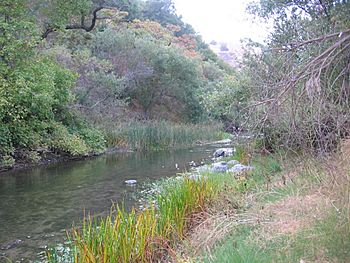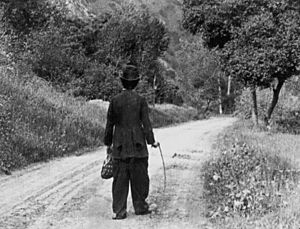Niles Canyon facts for kids
Quick facts for kids Niles Canyon |
|
|---|---|

Alameda Creek in Niles Canyon
|
|
| Native name | Arroyo de la Alameda, Cañada Molina Vallejo |
| Other name(s) | Alameda Canyon |
| Country | United States |
| State | California |
| Region | Alameda County |
| Physical characteristics | |
| Main source | head at Sunol, California 37°35′40″N 121°53′56″W / 37.59444°N 121.89889°W |
| River mouth | mouth at Niles, California 82 ft (25 m) 37°34′50″N 121°57′55″W / 37.58056°N 121.96528°W |
Niles Canyon is a beautiful canyon in the San Francisco Bay Area. It was carved out by Alameda Creek. This area is famous for its old trains and its connection to early silent movies.
Most of the canyon is in an area of Alameda County that isn't part of a city. However, the western part of the canyon is inside the cities of Fremont and Union City.
State Route 84, also called Niles Canyon Road, runs through the entire canyon. It connects the Niles area of Fremont to the town of Sunol. Two railroad tracks also follow this same path from Sunol to Niles. One is an old track, now the Niles Canyon Railway. The other is a newer track used by the Union Pacific Railroad. At the west end of the canyon, you can see the old Vallejo Flour Mill ruins, which date back to 1853.
A Look Back in Time
Long ago, an old trail called El Camino Viejo ran through Niles Canyon. This was one of the oldest north-south trails in California. The canyon, then known as Alameda Cañon, was also part of three different Mexican land grants. These were large areas of land given by the Mexican government.
The canyon was later named Cañada Molina Vallejo. This name came from a two-story adobe (a type of brick) grist mill built in the early 1840s. A grist mill grinds grain into flour. This mill was built near the canyon's entrance by José de Jesús Vallejo. He was the older brother of Mariano Guadalupe Vallejo, a famous Californian.
The area became known as Vallejo's Mill. Later, it was called Vallejo's Mills when a second wooden mill was built in 1856. This area eventually became the town of Niles. The town was named after the Niles Station, a train station built in 1869. This was after the first transcontinental railroad was completed through the canyon. The station was named after Addison C. Niles, a lawyer for the Central Pacific Railroad.
The railroad through Alameda Cañon was finished in August 1869. The first train from Sacramento to Alameda Terminal (the first end point of the Transcontinental Railroad) passed through the canyon on September 6, 1869. Around 1900, Niles became a popular spot for day trips and picnics. That's when the name Niles Canyon started to be used instead of Alameda Cañon.
Niles and the Movies
The Essanay Film Manufacturing Company, an early movie company, had a studio in Niles from 1912 to 1916. The canyon was used as a backdrop in many early films, including some by Broncho Billy Anderson. It was here that the famous Charlie Chaplin filmed one of his most well-known movies, The Tramp. Today, the Niles Essanay Silent Film Museum has exhibits and shows movies to remember this history.
Water for the City
The abandoned Sunol Aqueduct also runs through the canyon. This aqueduct was built in the 1920s. It used to provide half of the water supply to San Francisco. Later, it was replaced by the Hetch Hetchy Aqueduct.
Railroad Routes
The Union Pacific Railroad has an active mainline on the south side of Niles Canyon. This line is called the Oakland Subdivision. The Altamont Corridor Express train uses this line on weekdays and Saturdays.
The old Southern Pacific route from Oakland to Tracy through Niles Canyon is no longer used, except for one part. The section from Sunol to Niles Station is now operated by the heritage railway known as the Niles Canyon Railway.
This line was originally the westernmost part of the First Transcontinental Railroad. It connected Sacramento to San Francisco Bay. The Western Pacific Railroad finished it in September 1869. However, in 1879, a shorter route through Benicia became popular, and this line lost its main traffic.
The Southern Pacific tracks are on the north side of the canyon. Since Southern Pacific was the first railroad here, they chose the easiest path. When the Western Pacific tracks were built between 1905 and 1908, it was much harder. Engineers had to dig two tunnels and build a steel bridge. For the longer tunnel, two groups of workers dug from opposite ends, moving about 100 feet each month.


